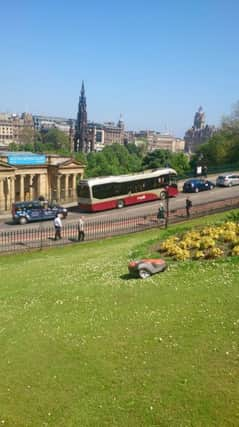Edinburgh scientists develop robots to clean trains and inspect railway bridges


The Heriot-Watt University researchers are working on robotised mobile inspection platforms that can operate in hard-to-reach areas such as between and under the seats of a train carriage.
They will detect hazards using an innovative algorithm and pick up rubbish such as discarded newspapers as well as dangerous items such as needles and blades.
Advertisement
Hide AdAdvertisement
Hide AdThe second project will develop autonomous drone technology to inspect railway bridge archways, particularly the inner curve which is difficult to access.
Scientists at Heriot-Watt University in Edinburgh are working in partnership with rail industry body the Rail Safety and Standards Board (RSSB) on the projects.
Dr Mustafa Suphi Erden, who is leading the research, said: “Initially our work will focus on developing a robotic mobile platform that can autonomously navigate in the confined space in between and under the seats of a train carriage. We will then develop an algorithm to detect cleaning and hazardous situations using a detailed set of train carriage images.
“We will also be creating a manipulator to integrate with the mobile platform to collect predefined objects regularly dropped or discarded by rail passengers such as bottles, paper cups, newspapers, and also biologically dangerous objects such as blades, needles, and injectors left behind by the passengers.”
Advertisement
Hide AdAdvertisement
Hide AdScientists will also develop drones which will collect images autonomously under the arches and will then automatically analyse the pictures to detect defects in the structure such as cracks, flakes, water seepage, insufficient mortar and misalignment.
Dr Erden said: “Our work will initially focus on developing the drone technology that can navigate itself using proximity sensors and webcams.
“These will allow the drone to control itself from one edge of the arch to the other through a horizontal line and turn back to follow a parallel path on another horizontal line.
“This level of accuracy, including maintaining an accurate distance from the surface of the arch, means every inch of the arch will be inspected in detail. We will then develop a machine learning algorithm to inspect the collected images and to detect a pre-identified set of hazards in the brickwork of the bridges.”
Advertisement
Hide AdAdvertisement
Hide AdRSSB is funding two four-year PhD studentships based at Heriot-Watt University.
Giulia Lorenzini, RSSB’s Senior Partnerships and Grants Manager, said: “The rail industry is only just starting to get to grips with what robotics and autonomous systems applications have to offer.
“It’s great to be working with a leading research institution in the field so that our members in rail can see evidence of the technology’s potential in a functioning, practical way.”